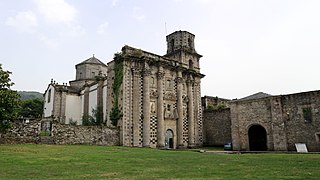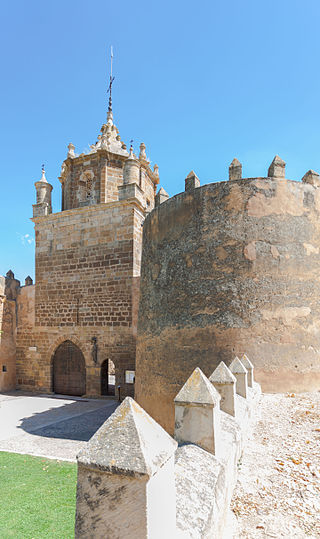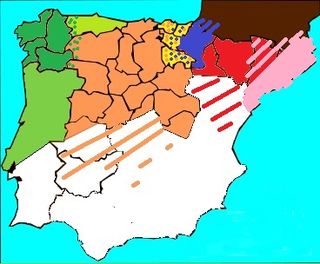
Huesca is a city in north-eastern Spain, within the autonomous community of Aragon. It was the capital of the Kingdom of Aragon between 1096 and 1118. It is also the capital of the Spanish province of the same name and of the comarca of Hoya de Huesca. In 2009, it had a population of 52,059, almost a quarter of the total population of the province. The city is one of the smallest provincial capitals in Spain.

The Castle of Loarre is a Romanesque Castle and Abbey located near the town of the same name, Huesca Province in the Aragon autonomous region of Spain. It is one of the oldest castles in Spain.

The Monastery of Santa Maria de Santes Creus, is a former Cistercian monastery in the municipality of Aiguamúrcia, Catalonia, Spain. The abbey was erected in the 12th century, in today's municipality of Aiguamúrcia, in the village of Santes Creus, in the province of Tarragona (Catalonia). However, it was in the thirteenth century when Peter III of Aragon expressed his desire to be buried in the monastery and a royal crypt was built for himself and his son, King James II that many of the local nobility established the custom to choose this place for burial. This led the monastery to increase in splendor and greatness thanks to the numerous donations received.

The monastery of San Juan de la Peña is a religious complex in the town of Santa Cruz de la Serós, at the south-west of Jaca, in the province of Huesca, Spain. It was one of the most important monasteries in Aragon in the Middle Ages. Its two-level church is partially carved in the stone of the great cliff that overhangs the foundation. San Juan de la Peña means "Saint John of the Cliff".

Monfero Abbey is a former Cistercian monastery dedicated to Mary, Mother of Jesus, in the province of A Coruña in Galicia, Spain. It is located in Monfero in Ferrolterra in the comarca of Eume, about 22 km to the north-east of Betanzos.

Veruela Abbey is a Cistercian abbey dating from the 12th century. It is situated near Vera de Moncayo, in Zaragoza province, Spain. It was founded in 1146 by Pedro de Atarés.

Vallbona Abbey, otherwise the Monastery of Santa Maria de Vallbona, is a Cistercian nunnery in Vallbona de les Monges, in the comarca of Urgell, Catalonia, Spain. Founded in the early 12th century, and built between then and the 14th century, it is one of the most important monastic sites in Catalonia. Its church represents an example of transition between Romanesque and Gothic architecture. The abbey was declared a national monument on 3 June 1931.

The Royal Abbey of Santa María de Alaón is a former Benedictine abbey, earlier a Cluniac priory, in Sopeira in the Pyrenean county of Ribagorza, Aragon, Spain, established in the late 11th or early 12th century over a 6th or 7th century foundation. The monastery is notable for its Lombard Romanesque architectural style.

The Abbey of San Pedro de Siresa is a monastery in the Valle de Hecho,. It was constructed between the 9th and 13th centuries, and is the northernmost monastery in Aragon.

The Abbey of Santa Engracia was a monastery in Zaragoza, Aragon, Spain, established to house the relics of Saint Engratia and the many martyrs of Saragossa. The date of 392 was traditionally claimed as a foundation date, which was linked with the travels of Saint Paulinus. The church was believed to have been sited on the spot of the martyrdom of Engratia.

Royal Monastery of Santa María de Sigena is a convent in Villanueva de Sigena, region of Aragon, Spain. Built between 1183 and 1208, the Romanesque church was founded by Queen Sancha of Castile, wife of Alfonso II of Aragon.

The Holy Cathedral of the Transfiguration of the Lord, also known as the Cathedral of Saint Mary of Huesca, is a Roman Catholic church in Huesca, in Aragon, north-eastern Spain. It is the seat of the Bishop of Huesca. Its architecture is Gothic, and its construction began in the late 13th century and was finished in the early 16th century.

San Pedro de Arlanza is a ruined Benedictine monastery in north central Spain. It is located in the valley of the river Arlanza in Hortigüela, Burgos. Founded in 912, it has been called the "cradle of Castile". It was abandoned in 1841 during the confiscations of Juan Álvarez Mendizábal's government, when ecclesiastical properties were roundly redistributed.
Monasteries in Spain have a rich artistic and cultural tradition, and serve as testament to Spain's religious history and political-military history, from the Visigothic Period to the Middle Ages. The monasteries played an important role in the recruitment conducted by Christian aristocracy during and after the progress of the Reconquista, with the consequent decline in the Muslim south of the peninsula.

The Monastery of Santa María de Huerta is a Cistercian monastery located in Santa María de Huerta, a town of the Spanish Province of Soria, within the autonomous community of Castile and León. The first stone of the building was laid by Alfonso VII of León and Castile in 1179.

Sant Serni de Tavèrnoles is a Romanesque Benedictine monastery in Anserall, in the municipality of Les Valls de Valira, Alt Urgell, in the Province of Lleida, Catalonia, Spain. It became a Bien de Interés Cultural site on 3 June 1931 and was restored in 1971.

The Casbas Monastery, also known as the Monastery of Santa Maria de la Gloria, is in Casbas de Huesca, a municipality in the province of Huesca, Aragon, Spain. A Bien de Interés Cultural, it was established in 1173 by Countess Oria de Pallars with the support of her husband Arnau Mir, Count of Pallars Jussà, between 1124 and 1174, and the Bishop of Huesca, Esteve de Sant Martí. Bishop Esteve had previously been the abbot of the Cistercian Monastery of Poblet from 1160 until 1165. The first abbess was Isabel, who ruled over the 30 noblewomen who entered the community until 1182. The abbess of Casbas had civil and criminal jurisdiction over her lands beginning in 1178. The Benedictine community of women formally came under the auspices of the Cistercian order in 1196, recognized as such by Pope Celestine III.

Spanish Romanesque designates the Romanesque art developed in the Hispanic-Christian kingdoms of the Iberian Peninsula in the 11th and 12th centuries. Its stylistic features are essentially common to the European Romanesque although it developed particular characteristics in the different regions of the peninsula. There is no Romanesque art in the southern half of the peninsula because it remained under Muslim rule (Al-Andalus). The examples of Romanesque buildings in the central area of the peninsula are sparse and of the latest period, with virtually no presence south of the Ebro and the Tagus. Most Romanesque buildings can be found in the northern third of the peninsula. Romanesque art was introduced into the peninsula from east to west, so scholars have usually defined regional characteristics accordingly: the "eastern kingdoms" comprising the Pyrenean areas, Catalan Romanesque, Aragonese Romanesque and Navarrese Romanesque, and the "western kingdoms" comprising Castilian-Leonese Romanesque, Asturian Romanesque, Galician Romanesque and Portuguese Romanesque.

The monastery of San Zoilo was a Benedictine monastery in Spain between the 10th and 19th centuries. Today, the complex, on the banks of the river Carrión in Carrión de los Condes, houses a luxury hotel.



















